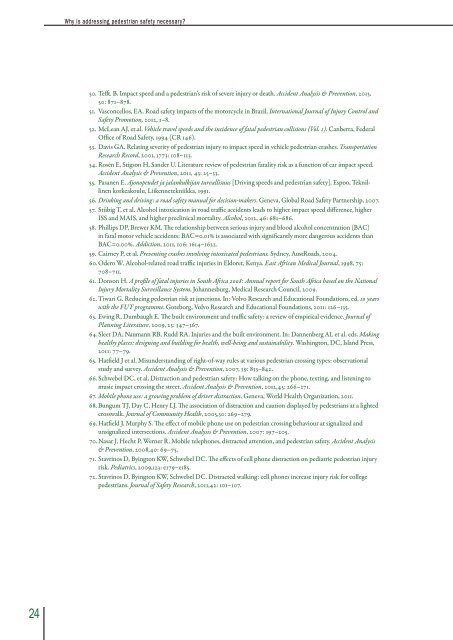Pedestrian safety - Global Road Safety Partnership
Pedestrian safety - Global Road Safety Partnership
Pedestrian safety - Global Road Safety Partnership
Create successful ePaper yourself
Turn your PDF publications into a flip-book with our unique Google optimized e-Paper software.
Why is addressing pedestrian <strong>safety</strong> necessary?<br />
50. Tefft. B. Impact speed and a pedestrian’s risk of severe injury or death. Accident Analysis & Prevention, 2013,<br />
50: 871–878.<br />
51. Vasconcellos, EA. <strong>Road</strong> <strong>safety</strong> impacts of the motorcycle in Brazil. International Journal of Injury Control and<br />
<strong>Safety</strong> Promotion, 2012, 1–8.<br />
52. McLean AJ, et.al. Vehicle travel speeds and the incidence of fatal pedestrian collisions (Vol. 1). Canberra, Federal<br />
Office of <strong>Road</strong> <strong>Safety</strong>, 1994 (CR 146).<br />
53. Davis GA. Relating severity of pedestrian injury to impact speed in vehicle pedestrian crashes. Transportation<br />
Research Record, 2001, 1773: 108–113.<br />
54. Rosén E, Stigson H, Sander U. Literature review of pedestrian fatality risk as a function of car impact speed.<br />
Accident Analysis & Prevention, 2011, 43: 25–33.<br />
55. Pasanen E. Ajonopeudet ja jalankulkijan turvallisuus [Driving speeds and pedestrian <strong>safety</strong>]. Espoo, Teknillinen<br />
korkeakoulu, Liikennetekniikka, 1991.<br />
56. Drinking and driving: a road <strong>safety</strong> manual for decision-makers. Geneva, <strong>Global</strong> <strong>Road</strong> <strong>Safety</strong> <strong>Partnership</strong>, 2007.<br />
57. Stübig T, et al. Alcohol intoxication in road traffic accidents leads to higher impact speed difference, higher<br />
ISS and MAIS, and higher preclinical mortality. Alcohol, 2012, 46: 681–686.<br />
58. Phillips DP, Brewer KM. The relationship between serious injury and blood alcohol concentration (BAC)<br />
in fatal motor vehicle accidents: BAC=0.01% is associated with significantly more dangerous accidents than<br />
BAC=0.00%. Addiction, 2011, 106: 1614–1622.<br />
59. Cairney P, et al. Preventing crashes involving intoxicated pedestrians. Sydney, Aust<strong>Road</strong>s, 2004.<br />
60. Odero W. Alcohol-related road traffic injuries in Eldoret, Kenya. East African Medical Journal, 1998, 75:<br />
708–711.<br />
61. Donson H. A profile of fatal injuries in South Africa 2008: Annual report for South Africa based on the National<br />
Injury Mortality Surveillance System, Johannesburg, Medical Research Council, 2009.<br />
62. Tiwari G. Reducing pedestrian risk at junctions. In: Volvo Research and Educational Foundations, ed. 10 years<br />
with the FUT programme. Goteborg, Volvo Research and Educational Foundations, 2011: 126–135.<br />
63. Ewing R, Dumbaugh E. The built environment and traffic <strong>safety</strong>: a review of empirical evidence. Journal of<br />
Planning Literature, 2009, 23: 347–367.<br />
64. Sleet DA, Naumann RB, Rudd RA. Injuries and the built environment. In: Dannenberg AL et al. eds. Making<br />
healthy places: designing and building for health, well-being and sustainability. Washington, DC, Island Press,<br />
2011: 77–79.<br />
65. Hatfield J et al. Misunderstanding of right-of-way rules at various pedestrian crossing types: observational<br />
study and survey. Accident Analysis & Prevention, 2007, 39: 833–842.<br />
66. Schwebel DC, et al. Distraction and pedestrian <strong>safety</strong>: How talking on the phone, texting, and listening to<br />
music impact crossing the street. Accident Analysis & Prevention, 2012,45: 266–271.<br />
67. Mobile phone use: a growing problem of driver distraction. Geneva, World Health Organization, 2011.<br />
68. Bungum TJ, Day C, Henry LJ. The association of distraction and caution displayed by pedestrians at a lighted<br />
crosswalk. Journal of Community Health, 2005,30: 269–279.<br />
69. Hatfield J, Murphy S. The effect of mobile phone use on pedestrian crossing behaviour at signalized and<br />
unsignalized intersections. Accident Analysis & Prevention, 2007: 197–205.<br />
70. Nasar J, Hecht P, Werner R. Mobile telephones, distracted attention, and pedestrian <strong>safety</strong>. Accident Analysis<br />
& Prevention, 2008,40: 69–75.<br />
71. Stavrinos D, Byington KW, Schwebel DC. The effects of cell phone distraction on pediatric pedestrian injury<br />
risk. Pediatrics, 2009,123: e179–e185.<br />
72. Stavrinos D, Byington KW, Schwebel DC. Distracted walking: cell phones increase injury risk for college<br />
pedestrians. Journal of <strong>Safety</strong> Research, 2011,42: 101–107.<br />
24






